Time:2025-07-15
The Synergy of Solar Power and Waterproof Neon in Modern Retail
In an era defined by sustainability goals and the need for climate-resilient design, solar-powered waterproof neon storefront signs have emerged as a groundbreaking solution for businesses seeking to blend environmental responsibility with robust visibility. These innovative signs marry the renewable energy of solar technology with the enduring appeal of waterproof neon lighting, enabling storefronts in rainy, humid, or coastal climates to shine brightly while minimizing their carbon footprint. By harnessing sunlight to power vibrant, weather-resistant displays, they offer a dual advantage: reducing reliance on grid electricity and ensuring consistent brand presence even in the harshest weather. This article explores the technical innovations, design principles, and strategic applications of these signs, providing a comprehensive guide for eco-conscious retailers, architects, and signage professionals.
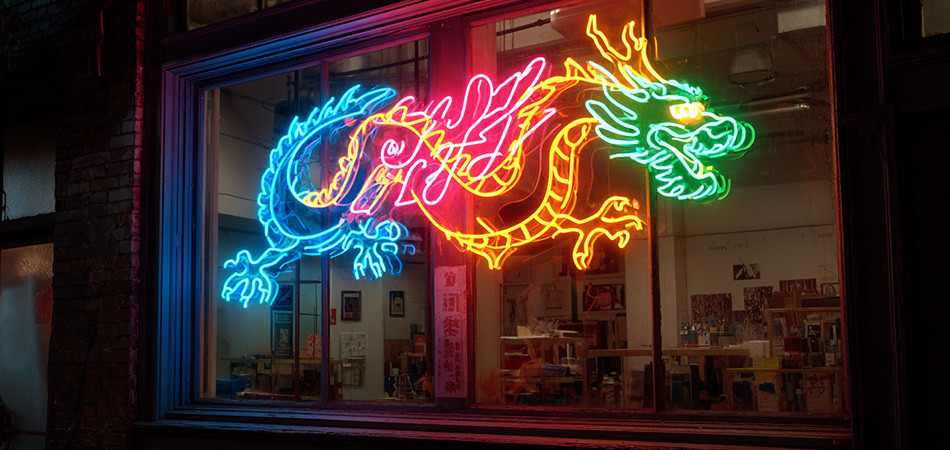
Technical Foundations: Merging Solar Energy with Waterproof Neon
Core Components of Solar-Powered Waterproof Systems
Solar Energy Harvesting Subsystem
Monocrystalline Solar Panels: High-efficiency panels (20-22% conversion efficiency) designed for outdoor use, featuring anti-reflective coatings and tempered glass to maximize energy capture even in overcast conditions. Panels are often mounted on store rooftops, awnings, or adjacent structures at optimal angles (25-45 degrees) to align with local solar paths.
Battery Storage Solutions: Lithium-ion or gel-cell batteries with deep-cycle capabilities, storing excess solar energy for nighttime operation. These batteries are encased in waterproof enclosures (IP65/IP67 rated) to withstand rain and humidity, with capacity optimized to provide 8-12 hours of illumination after sunset.
Waterproof Neon Lighting Subsystem
LED Neon Flex with IP Ratings: Surface-mounted LEDs encased in UV-stabilized silicone or PVC casings, rated IP65 for water jet resistance or IP67 for temporary submersion. This technology offers:
Durability: Resistance to impact, moisture, and salt spray, ideal for coastal or monsoon-prone regions.
Design Freedom: Bendable to 15mm radii for intricate logos and fonts, with RGB/RGBW capabilities to match brand colors while maintaining consistent light output in wet conditions.
Low-Voltage Compatibility: Operates at 12V/24V DC, seamlessly integrating with solar power systems and eliminating the need for high-voltage converters, enhancing safety and efficiency.
Smart Energy Management System
Charge Controllers: Regulate energy flow between solar panels, batteries, and neon lighting, preventing overcharging and optimizing power distribution. Features include:
MPPT (Maximum Power Point Tracking): Maximizes solar energy harvest even in low-light conditions.
Auto-Dimming: Light-dependent resistors (LDR) adjust neon brightness based on ambient light, conserving battery power during daylight hours.
Wireless Connectivity: Bluetooth/Wi-Fi modules in waterproof enclosures enable remote monitoring of energy usage, battery status, and lighting schedules via mobile apps, ideal for multi-location retailers.
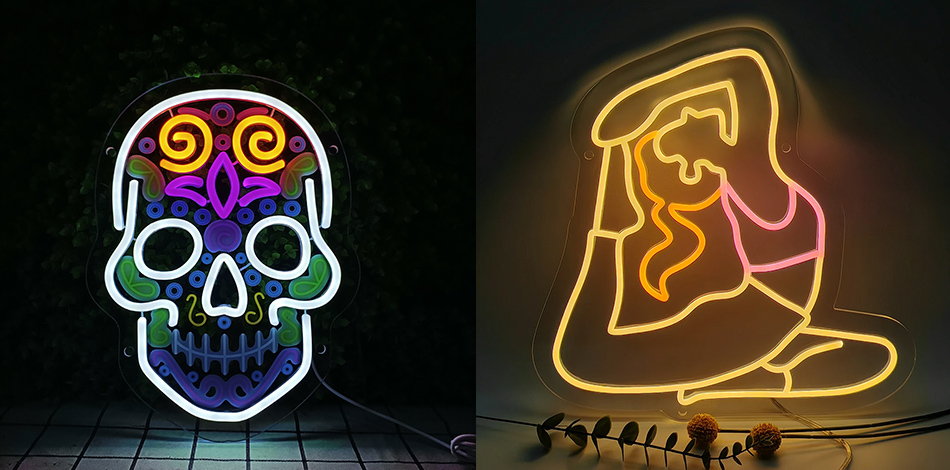
Design Principles for Solar-Ready Waterproof Signs
Sustainable Material Selection
Solar Panel Integration:
Aesthetic Panels: Black-framed or monocrystalline panels with sleek profiles, designed to blend with store facades (e.g., matching aluminum frames for modern architecture or wood-finished panels for rustic themes).
Bifacial Panels: Harvest sunlight from both sides, increasing energy yield in partially shaded areas, often used in conjunction with reflective backings to maximize efficiency.
Waterproof Components:
Recycled Silicone Casings: Neon flex encased in 30-50% post-consumer recycled silicone, certified by standards like the Global Recycled Standard (GRS) for eco-conscious brands.
FSC-Certified Backings: Wooden mounts sourced from sustainably managed forests, paired with waterproof sealants to resist moisture absorption.
Structural Design for Climate Resilience
Dual-Layer Sealing:
Primary Seal: Silicone overmolding around neon flex to create a watertight barrier against rain and humidity.
Secondary Seal: EPDM rubber gaskets in mounting frames, ensuring no water ingress at connection points between the sign and its backing.
Thermal Management:
Ventilation Channels: Micro-perforations in waterproof enclosures to dissipate heat generated by LEDs and batteries, preventing condensation buildup in humid climates.
Raised Mounting Brackets: Elevate signs 3-5cm from walls to create airflow gaps, reducing direct contact with moisture and promoting natural drying.
Optical and Electrical Synergy
Anti-Glare Coatings: Applied to silicone/PVC casings to reduce rain droplet reflection, ensuring neon text and logos remain legible during downpours.
Color Contrast Optimization: Pairing high-visibility colors (e.g., red, yellow) with neutral backings to cut through gray skies, combined with adaptive brightness algorithms that increase output during overcast conditions.
Energy-Efficient Lighting Modes: Pre-programmed settings like "Eco Mode" (50% brightness during off-peak hours) and "Boost Mode" (100% brightness during peak foot traffic), managed via the smart control system.
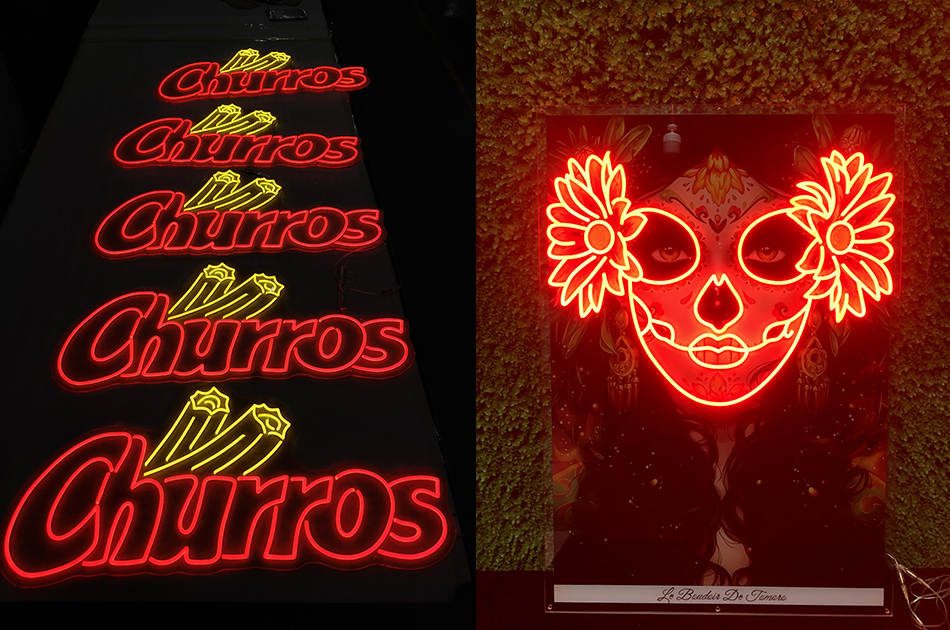
Strategic Applications in Diverse Climates
Coastal and Monsoon-Prone Retail Frontages
Beachside Boutiques and Resorts
Salt-Resistant Design: Stainless steel frames and marine-grade silicone casings protect against salt spray, with solar panels mounted on elevated rooftops to avoid sand accumulation. A beachwear store might use a wave-shaped neon logo, powered by solar panels integrated into its thatched roof, displaying "OPEN" in waterproof LED text that auto-activates at dawn.
Off-Grid Reliability: In remote coastal areas with unstable grid power, solar-powered signs ensure consistent visibility, with battery reserves lasting 48+ hours during cloudy periods, critical for tourist-dependent businesses.
Urban Stores in Rainy Metropolises
Dual-Purpose Awnings: Solar panels embedded in store awnings power waterproof neon signs, such as a café’s logo with integrated operating hours, reducing rooftop space usage and enhancing architectural cohesion.
Smart Weather Response: Sensors trigger "Rain Mode," dimming non-essential lighting elements while maintaining core brand messaging at full brightness, conserving energy without compromising visibility.
Temporary and Mobile Retail Setups
Pop-Up Shops and Market Stalls
Portable Solar Kits: Lightweight solar panels (5-10kg) paired with foldable neon signs, ideal for weekend markets in rainy regions. A craft vendor might use a battery-powered neon sign spelling "HANDMADE," with waterproof connectors enabling quick setup and teardown.
Eco-Friendly Festivals: Music festivals or sustainability expos feature solar-powered neon signage for food trucks and information booths, aligning with event green goals while withstanding sudden downpours.
Mobile Food Trucks and Vending Units
Roof-Mounted Solar Arrays: Compact panels on food truck roofs power waterproof menu boards, with neon highlights for signature dishes (e.g., "BURGERS" in red neon), visible even in stormy weather. The system’s low voltage ensures safety during vehicle movement and cleaning.
Indoor Wet Zones with Solar Integration
Spa and Wellness Centers in Humid Climates
Atrium Solar-Neon Displays: Solar panels in skylights power waterproof neon signs in steam rooms, displaying "RELAX" in soft blue neon, with humidity-resistant casings that prevent fogging and electrical shorting.
Eco-Certification Signage: LEED-certified buildings use solar-powered neon to highlight sustainability credentials (e.g., "GREEN BUILDING") in entrance lobbies, combining educational messaging with energy-efficient design.
Bath and Beauty Retail with Water Exposure
Makeup Testing Areas: Solar-powered neon signs indicating "TEST HERE" with waterproof backing, resisting splashes from sinks while using cool-white LED neon to enhance product visibility under humid conditions.
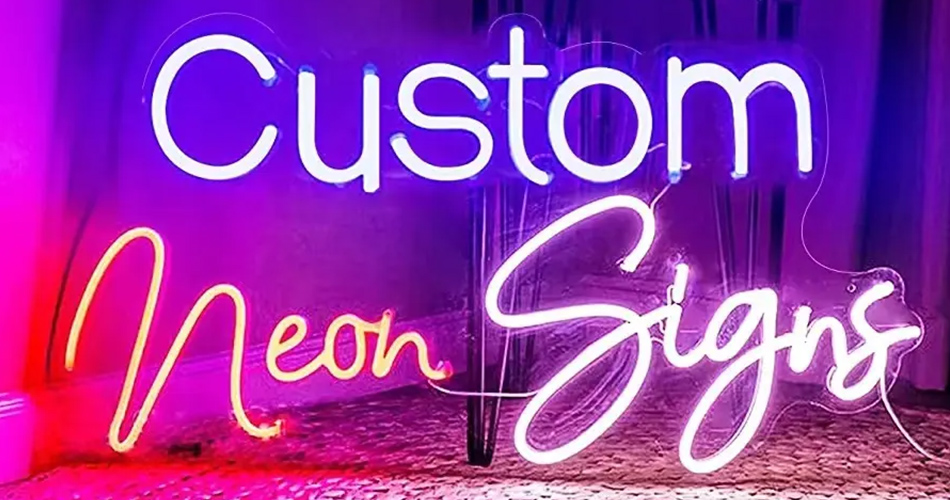
Installation and Maintenance Best Practices
Professional Installation: Merging Solar and Waterproofing Expertise
Site Assessment:
Solar Feasibility Study: Use solar irradiance maps to determine panel placement, ensuring minimum 4 hours of direct sunlight daily. For shaded areas, recommend supplementary battery capacity or higher-efficiency panels.
Structural Load Analysis: Calculate wind resistance (e.g., 120km/h for coastal zones) and roof load capacity, ensuring solar mounts and sign brackets meet local building codes.
Component Integration:
Waterproof Cable Management: Route wiring through PVC conduits elevated 30cm above ground, using IP67-rated glands at entry points to prevent water ingress into the sign’s interior.
Panel Mounting Techniques: Angle solar panels 10-15 degrees from vertical in rainy regions to facilitate rainwater runoff, paired with anti-rotation clamps to secure panels during storms.
Routine Maintenance: Ensuring Long-Term Performance
Solar Panel Care:
Monthly Cleaning: Remove debris and bird droppings with soft brushes and rainwater, avoiding abrasive materials that scratch anti-reflective coatings.
Annual Inspection: Check panel alignment and electrical connections, ensuring no corrosion at junction boxes or cable entry points.
Neon and Battery Maintenance:
Quarterly Seal Checks: Inspect silicone casings and gaskets for cracks, replacing damaged seals to maintain IP ratings.
Battery Health Monitoring: Use mobile apps to track battery charge cycles, replacing units when capacity drops below 80% to ensure consistent nighttime illumination.
Software Updates: Regularly update smart controller firmware to optimize MPPT algorithms and weather response features, ensuring peak energy efficiency.
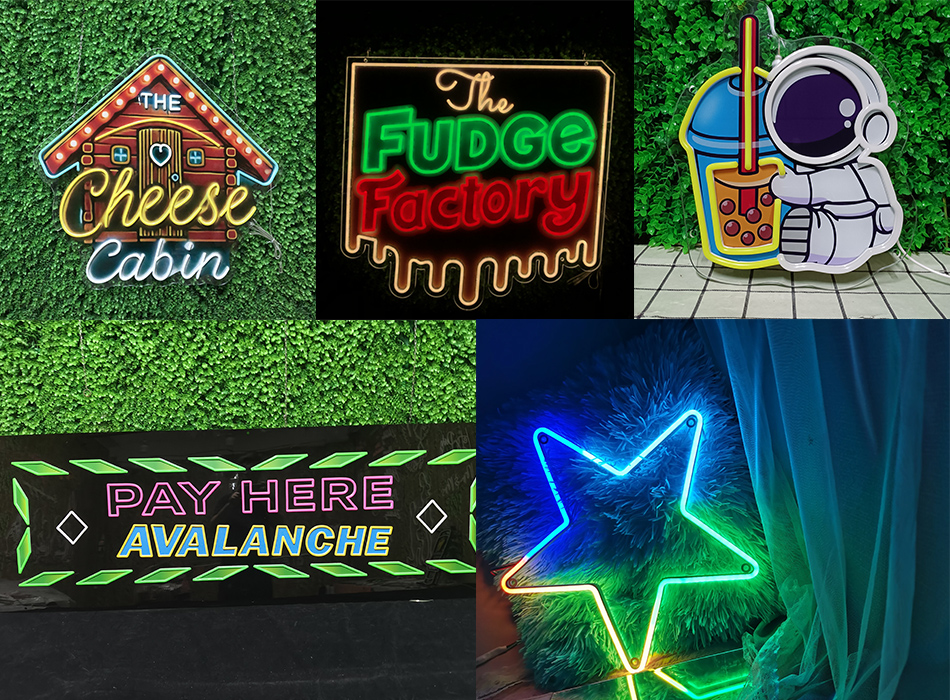
Key Considerations When Selecting Solar-Powered Waterproof Signs
Certification and Compliance
Dual Standards Compliance: Ensure solar panels meet IEC 61215 (solar performance) and neon components carry IP65/IP67 certification (IEC 60529), critical for insurance and regulatory approval.
Eco-Labels: Look for signs with Energy Star certification for solar efficiency or Cradle to Cradle certification for sustainable material use, enhancing brand credibility with eco-conscious consumers.
Supplier Expertise
Climate-Specific Experience: Prioritize manufacturers with case studies in similar environments (e.g., monsoon zones, coastal retail), demonstrating expertise in balancing solar efficiency and waterproofing.
In-House Testing Facilities: Suppliers with wind tunnels, salt spray chambers, and solar simulators ensure signs undergo rigorous climate testing before deployment.
Customization for Brand and Climate
Modular Design: Choose signs with replaceable solar panels and neon segments, allowing easy upgrades (e.g., higher-efficiency panels or new brand logos) without full system replacement.
Adaptive Lighting Features: Work with designers to integrate climate-specific modes, such as "Winter Boost" (longer battery runtime) or "Monsoon Dimming" (reduced brightness during heavy rain to preserve energy).
Budget and Lifespan Planning
ROI Calculation: While initial costs are 20-30% higher than grid-powered signs, factor in long-term savings from reduced electricity bills (50-70% energy cost reduction) and government incentives for renewable installations.
Lifespan Expectations: Solar panels (25+ years), LED neon (50,000+ hours), and batteries (5-7 years) create a total cost of ownership that favors long-term sustainability, with battery replacements easily integrated into maintenance plans.
Innovations Shaping the Future of Solar-Neon Signage
Advanced Solar Technologies
Perovskite Solar Panels: Emerging flexible panels with 25+% efficiency, ideal for curved storefronts or awning-integrated designs, offering higher energy yield in low-light conditions.
Solar Glass Integration: Transparent solar windows that harvest sunlight while displaying neon signs, combining architecture and energy generation for urban stores with limited rooftop space.
Smart Ecosystems and AI
Predictive Energy Management: Machine learning algorithms analyze weather forecasts and foot traffic data to optimize sign brightness and operating hours, ensuring maximum visibility during peak times while conserving energy during lulls.
Blockchain for Sustainability Tracking: Track the carbon savings of solar-powered signs via blockchain, providing consumers with real-time data on the store’s environmental impact, enhancing brand trust.
Circular Economy Design
Reusable Components: Signs designed for easy disassembly, with solar panels and neon modules eligible for second-life applications (e.g., outdoor events or community projects) at end-of-life.
Bio-Degradable Silicone: Plant-based casings that break down harmlessly after 10+ years of use, paired with recycled aluminum frames, creating fully sustainable signage solutions.
Overcoming Climate-Specific Challenges
Challenge 1: Reduced Solar Yield in Overcast Climates
Solution: Combine solar panels with small-scale grid backup systems (10-20% capacity), ensuring continuous operation during prolonged cloud cover while still achieving 80% renewable energy usage.
Challenge 2: Salt Deposits on Coastal Panels
Solution: Install automatic panel washers triggered by rain sensors, using fresh water to rinse salt buildup, paired with hydrophobic coatings that repel salt particles.
Challenge 3: Condensation in Enclosed Signs
Solution: Integrate miniature dehumidifiers or phase-change materials (PCM) inside waterproof enclosures, absorbing excess moisture to prevent fogging on neon surfaces.
Challenge 4: Wind Damage to Panels
Solution: Use aerodynamic panel mounts with quick-release mechanisms that auto-adjust during high winds, reducing wind load while maintaining energy capture.
Conclusion: The Future of Resilient and Sustainable Storefronts
Solar-powered waterproof neon storefront signs represent a transformative leap in retail signage, offering a harmonious blend of environmental responsibility, technical resilience, and visual appeal. By harnessing solar energy and waterproof technology, these signs empower businesses to thrive in the wettest and most challenging climates, all while reducing their carbon footprint.
As the world shifts toward sustainability and climate adaptability, these signs emerge as more than just lighting solutions—they are symbols of innovation and responsibility. For retailers, they offer a competitive edge by combining durability, energy efficiency, and brand visibility, while for the planet, they represent a step toward a greener, more resilient future. In regions where weather threatens both visibility and viability, solar-powered waterproof neon signs stand as a testament to human ingenuity, proving that even in the harshest environments, brands can shine brightly—powered by the sun, protected from the rain, and ready to welcome customers, day or night.